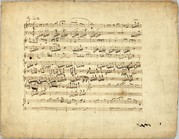



AI - Working autograph
| Date: | (1832) |
| Title: | [Agitato] |
| Dedication: | None |
The autograph includes the entire Etude, yet the notation of particular fragments differs in the level of finishing:
- The 1st section (bars 1-36), in spite of hasty and brief notation, is written quite accurately, with numerous performance indications, including dynamic indications, slurs, accents, staccato marks and even appassionato twice.
- The next section (bars 37-48) is already of a partially draft nature – only the part of the R.H. is written out with notes (without any performance indications) and instead of the part of the L.H., the indication come sopra appears several times, referring to the earlier notation of bars 1-12.
- The 2nd page of the manuscript includes an inaccurate draft of the part of the R.H. in bars 49-63 (without any indications concerning the L.H.) and a slightly more accurate notation of both hands in bars 64-67.
AI differs in numerous details from the later version of A, even if we do not take into account the performance indications, written randomly or inaccurately. One could mention here the mordents in bars 10-15, rhythm in bar 17, lack of mordent in bar 42, lack of octaves in bars 45-48, rhythm in bar 56, semiquavers in the L.H. on the 2nd quaver in bar 65.
The draft, hasty and inaccurate notation is revealed by erroneous notes, which are more numerous here than in fair scores, written at an inaccurate pitch due to a mistake (e.g., in bars 31-32) or inaccuracy (e.g., in bar 16). It follows from the fact that the manuscript was not meant to transfer the piece's text to someone else but it was dedicated only to the composer himself.
The Etude is written on the 1st and 4th pages of a double staff paper leaf. The 2nd page is empty, while on the 3rd there is a draft of the 2nd section of the Nocturne in G minor, Op. 15 No. 3 (from bars 86 to 152, which in this manuscript does not end the piece but leads to the return of the initial fragment, marked Da Capo). The sequence of pages adopted in mUltimate Chopin (2-1-4-3) allows for avoiding the separation of the Etude's text, while maintaining the order of pages featured in the original (the adjacent pages of the manuscript remain next to each other, except for the essentially unrelated pages 2 and 3).
| Original in: | Pierpont-Morgan Library, New York |

